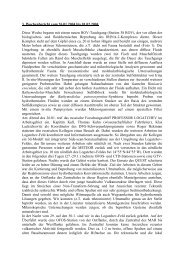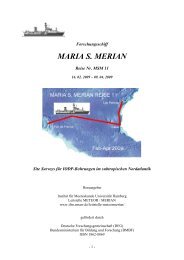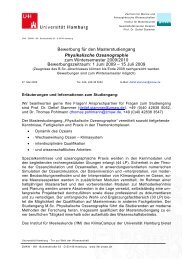MSM01_Expeditionsheft.pdf - Institute of Oceanography, University ...
MSM01_Expeditionsheft.pdf - Institute of Oceanography, University ...
MSM01_Expeditionsheft.pdf - Institute of Oceanography, University ...
Sie wollen auch ein ePaper? Erhöhen Sie die Reichweite Ihrer Titel.
YUMPU macht aus Druck-PDFs automatisch weboptimierte ePaper, die Google liebt.
Wissenschaftliches Programm<br />
Die Expedition dient drei Zielstellungen.<br />
Schwerpunkt ist dabei die Gewinnung von<br />
Sedimentproben im Rahmen eines Presite<br />
Survey für ein Baltisches IODP. Eine<br />
Gruppe von Geowissenschaftlern aus<br />
Dänemark, Deutschland, Estland, Finnland,<br />
Lettland, Litauen, Rußland und Schweden<br />
hatte 2004 einen Vorantrag “Paleoenvironmental<br />
evolution <strong>of</strong> the Baltic Sea<br />
Basin through the last glacial cycle” beim<br />
IODP Panel eingereicht. Die Hauptzielstellung<br />
ist dabei, hochauflösende<br />
Sedimentfolgen der Ostsee zu nutzen, um<br />
das Wechselspiel zwischen atlantischer<br />
Zirkulation und dem Klima Nordeuropas<br />
während der letzten 130 000 Jahre zu<br />
untersuchen. Dafür ist eine „Mission<br />
Specific Platform“ Kampagne vorgesehen.<br />
Nach seismischen Daten und festländischen<br />
Bohrungen sind nicht nur für das<br />
Spätpleistozän und Holozän sondern für den<br />
gesamten letzten glazialen Zyklus<br />
Sedimentfolgen in der Ostsee zu erwarten.<br />
So werden Folgen des Eem-Interglazials im<br />
Kattegat vermutet, während Sedimente der<br />
südlichen Ostsee, die vor dem LGM eisfrei<br />
gewesen sein dürfte, Aufschluß über das<br />
frühe und mittlere Weichsel-Glazial geben<br />
dürften. Das Spätpleistozän und Holozän ist<br />
in hochauflösenden Sedimentfolgen der<br />
nördlichen Ostsee am vollständigsten<br />
repräsentiert. Mit der Merian-Expedition<br />
werden 4 Arbeitsgebiete des Kattegats und<br />
der südlichen Ostsee untersucht, nachdem<br />
bereits ein geophysikalischer Presite Survey<br />
mit dem Forschungsschiff „Heincke“ vom 6.<br />
bis 16.2.2006 vorgeschaltet worden war. Es<br />
werden in folgenden Gebieten und ihren<br />
Umgebungen Untersuchungen der<br />
Oberflächenbeschaffenheit des<br />
Meeresbodens mit dem Fächerecholot und<br />
einer Unterwasserkamera (ROV)<br />
vorgenommen und Sedimentkerne<br />
entnommen:<br />
Fahrtabschnitt / Leg <strong>MSM01</strong>/2<br />
27.03. – 06.04.2006<br />
Warnemünde – Warnemünde<br />
Fahrtleiter / chief scientist Pr<strong>of</strong>. Dr. J. Harff<br />
- 16 -<br />
Scientific Program<br />
The Expedition has three goals, with emphasis<br />
on the acquisition <strong>of</strong> sediment samples as<br />
a pre-site survey for a Baltic IODP. In 2004<br />
a group <strong>of</strong> scientists from Denmark, Estonia,<br />
Finland, Germany, Latvia, Lithuania, Russia,<br />
and Sweden had submitted a preproposal<br />
for a Baltic IODP “Paleoenvironmental<br />
evolution <strong>of</strong> the Baltic Sea<br />
Basin through the last glacial cycle”. The<br />
general aims <strong>of</strong> the project is to use the high<br />
resolution sedimentary record <strong>of</strong> the Baltic<br />
Sea in order to reconstruct the climatic response<br />
<strong>of</strong> Northern Europe to the forcing <strong>of</strong><br />
the Northern Atlantic atmospheric and oceanic<br />
circulation system during the last c.<br />
130 000 years. It is anticipated to close the<br />
gaps in knowledge by the mission specific<br />
IODP drill campaign. Information from<br />
seismic surveys and onshore drill results<br />
imply that the Baltic Sea will not only host<br />
complete sedimentary sequences in high<br />
resolution for the Late Pleistocene and<br />
Holocene but also for the entire last glacial<br />
cycle. Eemian sequences are expected particularly<br />
in the Kattegat area. The southern<br />
Baltic Sea which is regarded having been<br />
ice free before the LGM is prospective for<br />
complete records <strong>of</strong> the early and middle<br />
Weichselian, whereas the Northern Baltic<br />
Sea hosts late Pleistocene to Holocene<br />
sediments with high resolution. During the<br />
expedition 4 sites and their vicinities will be<br />
investigated in terms <strong>of</strong> the sea floor features<br />
using a multibeam echosounder and<br />
the uppermost sediments which have to be<br />
sampled with gravity and vibro-corers.<br />
Kattegat: “IODP-Site BB-4”.<br />
Südliche Ostsee: “IODP-Sites BB-2A, BB-<br />
2B, BB-2C“.


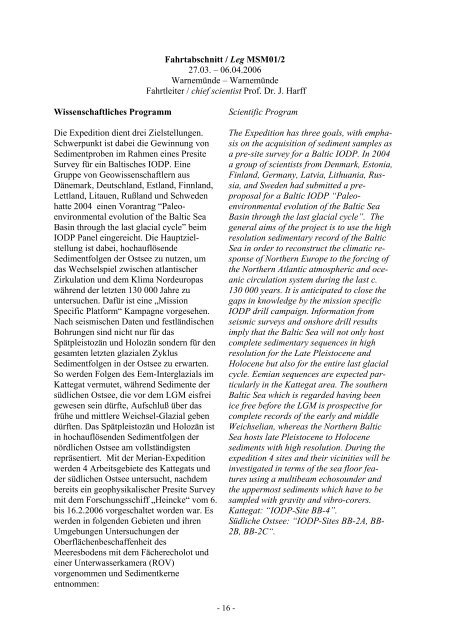
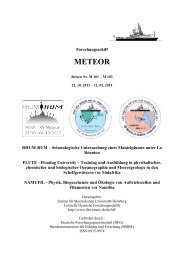

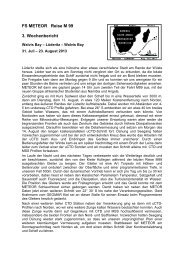
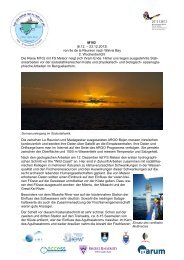
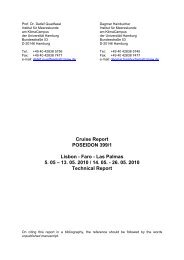
![Expeditionsheft Reisen M99-M100 [pdf] - Institute of Oceanography ...](https://img.yumpu.com/22533092/1/184x260/expeditionsheft-reisen-m99-m100-pdf-institute-of-oceanography-.jpg?quality=85)
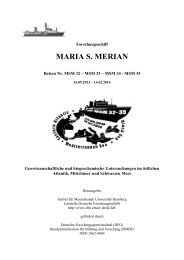
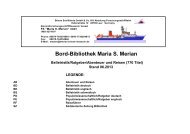
![Darstellungen [pdf]](https://img.yumpu.com/22533086/1/184x260/darstellungen-pdf.jpg?quality=85)



